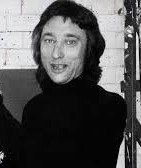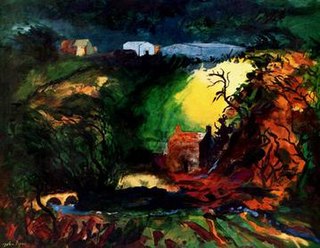
Barney Bubbles was an English graphic artist whose work encompassed graphic design and music video direction. Bubbles, who also sketched and painted privately, is best known for his distinctive contribution to the design practices associated with the British independent music scene of the 1970s and 1980s. His record sleeves, laden with symbols and riddles, were his most recognisable output.

John Egerton Christmas Piper CH was an English painter, printmaker and designer of stained-glass windows and both opera and theatre sets. His work often focused on the British landscape, especially churches and monuments, and included tapestry designs, book jackets, screen-prints, photography, fabrics and ceramics. He was educated at Epsom College and trained at the Richmond School of Art followed by the Royal College of Art in London. He turned from abstraction early in his career, concentrating on a more naturalistic but distinctive approach, but often worked in several different styles throughout his career.

The Musée des Arts Décoratifs is a museum in Paris, France, dedicated to the exhibition and preservation of the decorative arts. Located in the city’s 1st arrondissement, the museum occupies the Pavillon de Marsan, the north-western wing of the Palais du Louvre. With approximately one million objects in its collection, the Musée des Arts Décoratifs is the largest museum of decorative arts in continental Europe. It is one of three museums operated by the non-profit arts association MAD, founded in 1882.
Abram Games was a British graphic designer. The style of his work – refined but vigorous compared to the work of contemporaries – has earned him a place in the pantheon of the best of 20th-century graphic designers. In acknowledging his power as a propagandist, he claimed, "I wind the spring and the public, in looking at the poster, will have that spring released in its mind." Because of the length of his career – over six decades – his work is essentially a record of the era's social history. Some of Britain's most iconic images include those by Games. An example is the "Join the ATS" poster of 1941, nicknamed the "blonde bombshell" recruitment poster. His work is recognised for its "striking colour, bold graphic ideas, and beautifully integrated typography".

Tom Eckersley OBE was an English poster artist and teacher of design.

A poster is a large sheet that is placed either on a public space to promote something or on a wall as decoration. Typically, posters include both textual and graphic elements, although a poster may be either wholly graphical or wholly text. Posters are designed to be both eye-catching and informative. Posters may be used for many purposes. They are a frequent tool of advertisers, propagandists, protestors, and other groups trying to communicate a message. Posters are also used for reproductions of artwork, particularly famous works, and are generally low-cost compared to the original artwork. The modern poster, as we know it, however, dates back to the 1840s and 1850s when the printing industry perfected colour lithography and made mass production possible.
Mary Merlin Kessell was a British figurative painter, illustrator, designer and war artist. Born in London, she studied at the Clapham School of Art, then later at the Central School of Arts and Crafts. At the end of the Second World War, she was commissioned to work in Germany as an official British war artist; one of only three women selected. She spent six weeks in Germany, travelling to the recently liberated Bergen-Belsen concentration camp as well as other major cities including Berlin. She produced charcoal drawings of refugees, primarily of women and children which she subsequently sold to the War Artists Advisory Committee. After the war Kessell collaborated with the Needlework Development Scheme, NDS, to produce experimental designs for machine and hand embroidery as well as working for Shell as a designer. She later returned to the Central School to teach at the School of Silversmithing and Jewellery alongside the painter Richard Hamilton.

The Reimann School of Art and Design was a private art school which was founded in Berlin in 1902 by Albert Reimann, and re-established in Regency Street, Pimlico, London in January 1937 after persecution by the Nazis. It was the first commercial art school in Britain.

Reginald Mount (1906–1979) was a British graphic designer.
Dorrit Dekk was a Czech-born British graphic designer, printmaker and painter.

Jacqueline S. Casey was a graphic designer best known for the posters and other graphic art she created for the Massachusetts Institute of Technology (MIT). While practicing a functional Modernism, Jacqueline S. Casey was a graphic designer in the Office of Publications from 1955 to 1989, and was appointed director in 1972. In discussing her design, Casey stated, "My work combines two cultures: The American interest in visual metaphor on the one hand, and the Swiss fascination with planning, fastidiousness, and control over technical execution on the other."

Hans Arnold Rothholz (1919–2000) was a poster designer and graphic artist born in Dresden, Germany, who immigrated to Britain in 1933. Interned as an enemy alien during the early part of the Second World War, he designed posters for the Royal Society for the Prevention of Accidents and other clients including Wembley Stadium, Ealing Studios and other major clients between 1942 and the 1960s. Along with fellow designers Tom Eckersley, George Him and Abram Games, he has been credited with "transform[ing] visual communication in Britain".
Edwin Embleton was a commercial and graphic designer who is widely recognised for his work in the Publications Division of the Ministry of Information during the Second World War.
Charles Alfred Mozley was a British artist who was also a teacher. He was a prolific book illustrator and designer of book covers, posters and prints.
Jan Le Witt (1907–1991) was a Polish-born British abstract artist, graphic designer and illustrator. He had a long professional partnership with George Him. As a design company, Lewitt-Him brought an innovative use of colour, abstraction and symbolism to commercial design. They established a reputation for fine poster work during World War Two and for exhibition displays, most notably with the Guinness clock for the Festival of Britain. The partnership dissolved in 1955 when Le Witt decided to concentrate upon his own, often abstract, art.

George Him was a Polish born British designer responsible for a number of notable posters, book illustrations and advertising campaigns for a wide range of clients.
John Mansbridge (1901–1981) was a British artist. He was an official war artist during World War II and Head of Fine Art at Goldsmiths College in London.
Rosemary Ellis née Collinson (1910–1998) was a British artist, graphic designer and teacher known for her poster and book jacket designs.

Hans Schleger was a German-Polish-Jewish and later British graphic designer.
Heather "Herry" Perry was a graphic artist, illustrator, and printmaker best known for her prolific design work for Transport for London and London Underground throughout the 1920s and 1930s.











